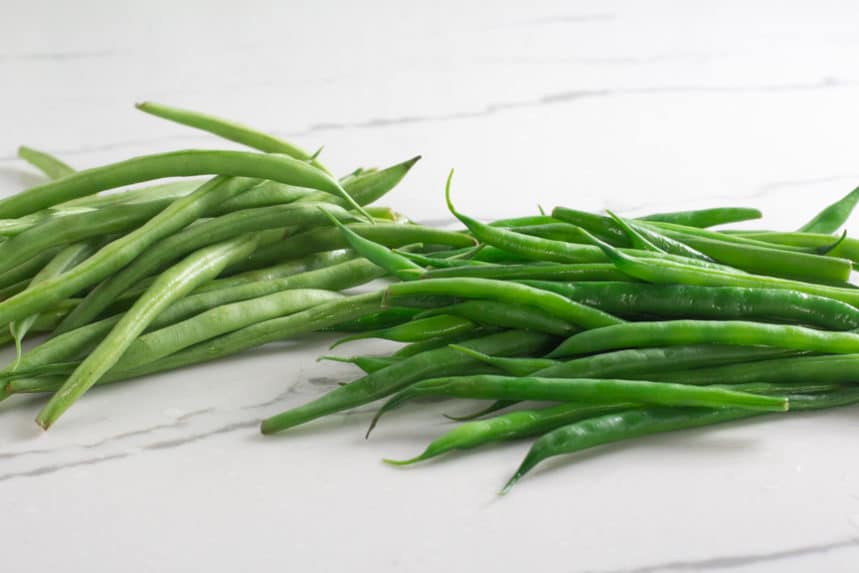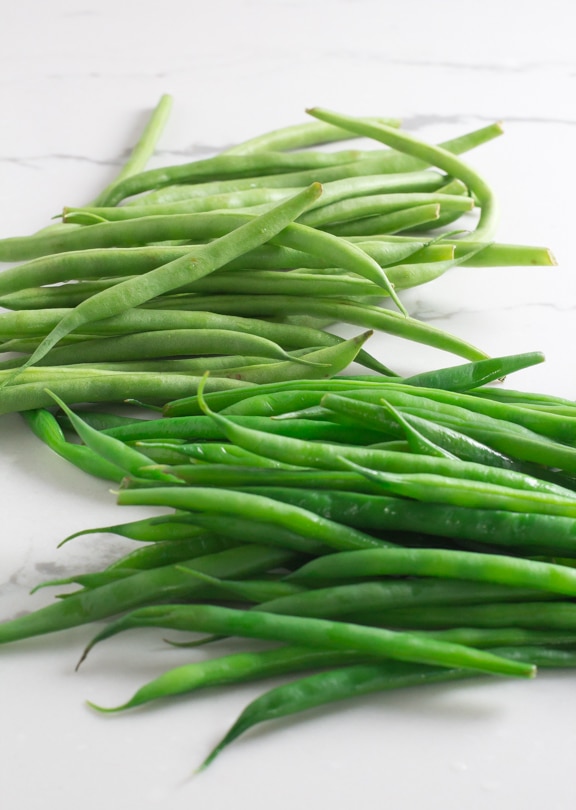About Green “String” Beans
Monash University recommends a serving of 15 green beans (75 g).
Prior to the late 1800s most beans of this sort had “strings”, which were a tough stringy piece that had to be removed before eating. Now our green beans are relatively string-less, but the moniker remains. To add to the confusion, not all string beans are green, so what to call them is a bit of a trap. You might also see them labeled as French beans or snap beans. There are the most common green ones, of course, but you can also find yellow ones, often called wax beans, purple beans, which turn green when cooked, extra thin delicate ones called haricot verts, which are particularly flavorful, and extra large, broad ones called Italian Romano. Below in the image are green beans, raw on the left and blanched on the right.
Green Beans
Green beans (Phaseolus vulgaris) are the most common and what we will focus on. Green beans are given the Green Light by Monash, and while this means you can eat multiple servings of Green Light foods per meal, know that extra large servings of green beans (25 beans or more) will be high in the Polyol Sorbitol, so be mindful. Green beans are incredibly versatile – they make great finger food for toddlers and flesh out a crudité platter. We use them blanched for salad Nicoise, toss them in stir-fries, and simmer in soups. Raw, warm or cold we use them year round.
How to Buy
Look for vividly green beans. The texture should be crisp, never limp. The seeds should be small, which will accompany a smooth, streamlined look on the outside; larger seeds, which can negatively affect taste and texture, will make the beans look a bit bumpy.
How to Prep & Use
Wash and simply snap off them stem end. Occasionally a bit of a vestigial “string” will come off as well; discard. We like to keep the other end intact with its little curly “tail”, but you can snip that off as well.
If you find a recipe calling for “Frenched” beans, simply slice them lengthwise in half.
If you are plunging them into boiling water to blanch them (lightly cook) for crudité or other uses such as in our Low FODMAP Gado-Gado, make sure to run under cold water after draining to stop cooking. This will help retain their crisp texture and vivid green color. You can also drop them into an ice water bath. If sautéing to serve as a simple side dish, we recommend serving as soon as they are cooked; they tend to loose their vibrant color upon standing. Also check out our Green Beans with “Onions”. In any event, they require very brief cooking.
How to Store
Store green beans in a paper bag or wrap in a paper towel slipped into a plastic bag and place in the crisper drawer. Use within the week and preferably within 4 days.
Varieties
There are bush types and pole types and these names refer to how the beans grow. The bush types can grow without support. Pole beans climb support as they develop. They are an early crop and associated with spring harvests.



